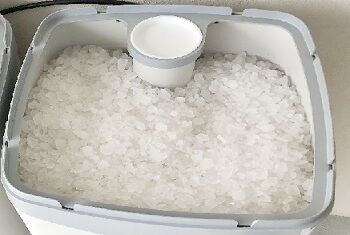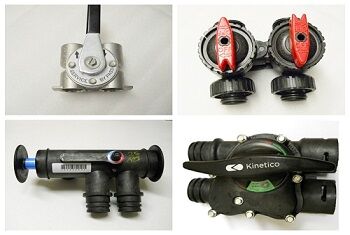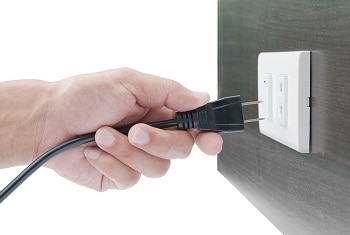You check your water softener brine tank and discover that your water softener has run out of salt! You think “When was the last time that I added salt to my brine tank”, “Is my water softener going to be OK”, and then you wonder, How Long Can My Water Softener Go Without Salt?
A water softener will continue to soften your water without salt until its water softener resin has removed its maximum capacity of hardness from your water. A water softener can go without salt in-between regenerations and only uses salt during scheduled regenerations.
Basically, a water softener does not need to have salt in its brine tank to soften your water. But you should be sure to add salt to your water softener brine tank before the water softener needs to regenerate so the water softener resin can be regenerated by the salt’s sodium ions.
Why Does A Water Softener Need Salt To Soften Your Water?

A water softener uses the sodium ions from salt or potassium chloride in a process called “Ion Exchange” to remove the hardness that has collected on the water softener resin inside of the water softener.
The water softener resin will then be able to remove hardness from your water until the water softener resin has removed its maximum capacity of hardness from your water.
When your water softener resin can no longer remove any more hardness from your water, the hardness will remain in your water until salt or potassium chloride is added to the brine tank and the water softener resin is regenerated.
How To determine how long YOUR water softener can go without salt.
By knowing the hardness of your water and the approximate volume of water that is used in your home per day, you can figure out how long YOUR water softener can go without salt.
Not sure what your water hardness is? You can easily find out your water hardness by using a simple Water Hardness Test Kit.
- Find out how hard your water is by using a Water Hardness Test Kit.
- Check your water for iron with an Iron Test Kit.
- Add 3 (Grains Per Gallon) to your water hardness for every 1 part per million of iron in your water to determine your water (Total) hardness.
- Multiply your total hardness by 75 (an average of gallons of water used per person per day) for each person in your home to determine how much water hardness needs to be removed from your water each day.
- Determine your water softener (True) water softening capacity based on the approximate advertised water capacity on popular water softener capacity sizes.
- Divide your (True) water softener capacity by the amount of water hardness to be removed from your water each day and you will have the approximate amount of days that your water softener can go without salt.
Some popular water softener capacity sizes and their estimated realistic and efficient true capacities.
- 24,000 = (15,000) True Water Softener Capacity
- 32,000 = (20,000) True Water Softener Capacity
- 48,000 = (30,000) True Water Softener Capacity
- 56,000 = (35,000) True Water Softener Capacity
- 64,000 = (40,000) True Water Softener Capacity
True water softener capacities are the estimated capacity of the water softener resin being regenerated most efficiently and NOT the maximum potential capacity of the water softener resin. True capacities are estimated at 62.5% of the total resin capacity.
When Does A Water Softener Use Salt?
A water softener ONLY uses the salt in its brine tank when the water softener needs to regenerate its water softener resin!
Want to learn more about when and how your water softener uses salt? See my article “What Happens When A Water Softener Regenerates“
In other words, the only time that a water softener actually needs to have salt in its brine tank is when it needs to dissolve the salt in the brine tank to create brine which is used in the ion exchange process that replaces the hard minerals that have collected on the water softener resin with sodium ions from the salt in the water softener brine tank.
This doesn’t mean that you should only have salt in your brine tank when it needs to regenerate its water-softener resin, it just means that if your water softener does not have salt in its brine tank in-between regenerations, it can still soften your water until it needs the salt for the next regeneration.
Watch this quick video about how a water softener uses the salt from a brine tank.
What Happens When A Water Softener Runs Out Of Salt?
When a water softener runs out of salt, it will not have the sodium ions from the salt that it needs to remove the hard minerals that have collected on the water softener resin inside of the water softener tank.
When this happens the hard minerals will continue to accumulate on the resin until it can no longer remove any more hard minerals from your water and your water will no longer be softened by your water softener.
Want to learn more? Read my detailed article about “What Happens When Your Water Softener Runs Out Of Salt” and “Why Is My Water Softener Brine Tank Full Of Water?“.
Pro Tip: Keep a few extra bags of water softener salt in an area other than next to your water softener for when you run out of salt. When you run out of salt in your brine tank you can use these backup bags of salt until you can get more.
Doesn’t A Water Softener Use Salt To Soften Your Water?
Not Exactly!
A water softener does NOT add salt to your water to make your water soft!
Your water softener is not using the salt in its brine tank 24 hours a day 7 days a week to make your hard water soft.
Your water gets softened as it passes through the water softener resin inside the water softener tank. As the water passes through the resin, the hard minerals in the water get drawn out of the water by the resin and get collected on the surface of the resin.
The salt is ONLY used during the water softener regeneration process to remove the hard minerals from the resin by replacing the hard ions with sodium ions from the salt.
Should I Bypass My Water Softener If It Runs Out Of Salt?

There is normally no need to bypass your water softener just because it has run out of salt!
In fact, your water softener should still provide you with softened water for a period of time after it has run out of salt, and if you bypass your water softener, you will get untreated (HARD) water going into your home.
Should I Unplug My Water Softener If It Runs Out Of Salt?

There is usually no reason to unplug your water softener just because your water softener has run out of salt. Unplugging your water softener will prevent it from regenerating and you may lose the programming in your water softener’s computer.
If your water softener regenerates without salt, there should be no harm to the water softener resin but hard minerals may get into the control valve of your water softener which could cause damage to the internal parts of the valve.
To Sum Up:
Your water softener can still provide softened water to your home for a period of time after it has run out of salt.
Providing that you add salt back to the brine tank before the water softener needs to use salt again for its regeneration process, you should have an uninterrupted supply of softened water and there should be no negative effects on your water softener.
Make sure to check your water softener’s brine tank regularly to make sure that it never runs out of salt. If it does run out of salt, be sure to add salt to the brine tank ASAP.


I have a 4040s that is making the water very salty , burns my eyes in the shower & makes my skin very slippery!how do I adjust it .bought it new in 10/6/20. My last unit went trouble free for 16 years .T hat’s why I bough another one ..please help THANK YOU .
Hello Mr. Belanger and thank you for the question.
Salty water from a Kinetico water softener is almost always due to poor water pressure going to the system or the brine float is set too high.
I suggest that you change your sediment prefilter cartridge if you have one and then contact the Kinetico dealer that installed it for you to ask them about your water test results and how high your brine float should be.
Also check out my article about “Salty Water From My Kinetico Water Softener”
I hope this was helpful.
Paul